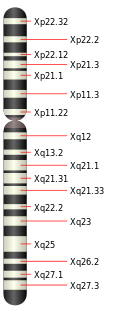Chromosomal sex determination
From WikiLectures
In general[edit | edit source]
- applied to gonochorists (animals with separate male and female sexes); gender is determined at different stages of their ontogenetic development; for most, the sex is already determined at conception
- based on the existence of sex chromosomes : the defining role belongs to the sex chromosomes (heterochromosomes, gonosomes), which are a normal part of the chromosomal equipment of every cell in the organism
- 2 types of sex chromosomes – chromosome X and chromosome Y – sex is determined by their mutual combination
- in the haploid set of the gamete there is 1 gonosome, all others are autosomes (in humans there is 1 gonosome and 22 autosomes in the gamete)
Human X chromosome
- in a diploid cell there is normally 1 pair of gonosomes – a combination of XX or XY + a species-specific number of homologous pairs of autosomes
- sex chromosomes – morphologically striking; a significant part is made up of heterochromatin (= chromatin that remains spiralized [stains darkly] throughout the cell cycle - genetically inactive), which does not spiralize in interphase and is evident in it
- The Y chromosome is usually significantly smaller than the X chromosome, including all autosomes
- in humans (as well as in most animals) they determine the sex of the sperm (it is heterogametic) - it can carry both an X and a Y chromosome The human Y chromosome
- at fertilization, there is a 50% probability of both male and female sex (during meiotic formation of sex cells, all oocytes contain the same X chromosome, but in sperm there is a 50% probability that either X or Y is present - in fusion, with a 50% probability, both an XX zygote is produced (a girl ), so zygote XY (boy))SRY protein
- the created chromosome equipment of the zygote is gradually passed on to all the cells of the organism that develop from it through its furrowing (i.e. mitotic division)
- during gametogenesis (I. meiotic division) both gonosomes separate again and each gamete receives only 1 of them
- the Y chromosome carries a highly condensed SRY region (sex determining region of Y) on short arms.
This contains genes for the determination of male gonads, which are homologous to the genes for the formation (TSPY) of non-histone nuclear proteins (TSPY gene product, binds to the cytochrome P450 gene promoter - aromatase, which converts testosterone into female estradiol)
- inactivation of the gene for cytochrome - P450 - aromatase in the embryo preserves the activity of the produced testosterone and determines the male sex
- The TSPY protein also binds to the promoter of the Müller inhibitory substance gene, its activation in the male embryo leads to the differentiation of the testes and the regression of the female gonads
Basic types of gender determination[edit | edit source]
Mammalian type (Drosophila type)[edit | edit source]
- mammals including humans, some amphibians, reptiles, most orders of insects and most dioecious plants
- sex: XX (homogametic) forms eggs with only X chromosome (female)
- sex: XY (heterogametic) sperm with either X or Y chromosomes in a ratio of 1:1 (males)
Bird type (Abraxas type)[edit | edit source]
- birds, some fish, some amphibians and butterflies
- gender: ZW (female)
- gender: ZZ (males)
Links[edit | edit source]
[edit | edit source]
External links[edit | edit source]
Source[edit | edit source]
- ŠTEFÁNEK, Jiří. Medicína, nemoci, studium na 1. LF UK [online]. [cit. 2009]. <http://www.stefajir.cz>.





